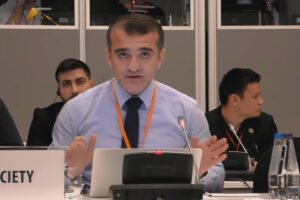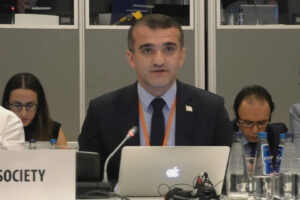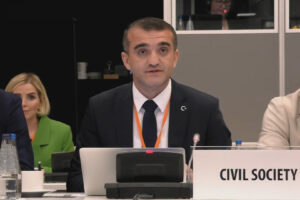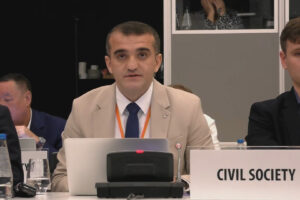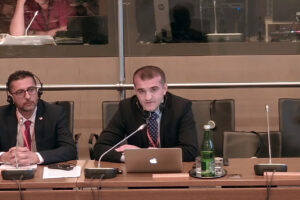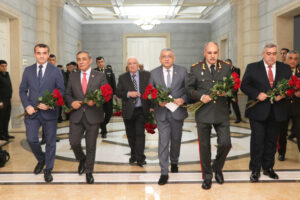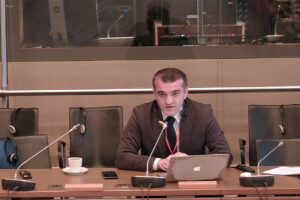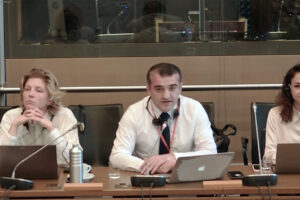Why America must step up its role in resolving Armenian-Azerbaijani conflict


Washington — This May marked the 20th anniversary of the cease-fire in the conflict between Armenia and Azerbaijan over the Nagorna-Karabakh region. That is hardly an occasion to celebrate: This conflict remains unresolved, and in the aftermath of the Crimea conflict, is arguably both more dangerous and more relevant than ever to US interests.
If Crimea is the latest “frozen” conflict in Eurasia, the one over Nagorno-Karabakh was the mother of the territorial conflicts of the former Soviet Union. The conflict over that mountainous territory pitted two post-Soviet republics in the strategic South Caucasus against one another, and has remained unresolved since the cease-fire 20 years ago. It also set the tone for a series of territorial conflicts with geopolitical overtones in South Ossetia, Abkhazia, and Transnistria – and eventually in Crimea.
Just like Crimea, Karabakh featured a territory with a disputed history, a contentious status, and a majority population with affiliations to a neighboring state. But like Crimea, Karabakh was never just about the locals. The conflict always featured a third player: Moscow, which from day one played a key role in determining the outcome of the conflict. It helped instigate the violence and armed both sides, calibrating releases of weapons to achieve a stalemate that left both countries weak and exposed to Russian pressure. To this day, it remains Russia’s policy to maintain a controlled instability between the two countries, using the conflict to cement its control over Armenia, and to weaken pro-Western Azerbaijan.
In a tragic irony, the war turned a winner into a loser. Much smaller than Azerbaijan in terms of wealth, population and territory, Armenia was able to use Russian help to take control not only of the disputed territory itself, but of seven adjacent areas of Azerbaijan. Armenia had enjoyed considerable sympathies in the West, but its policies of ethnic cleansing turned it into an aggressor in the eyes of the world community. It also led to Armenia’s international isolation.
On the other hand, Azerbaijan began developing its large oil and gas resources, and its GDP is now five time larger than Armenia’s. Armenia has found itself with a shrinking population and a total dependence on Russia to maintain its territorial gains. Yet Azerbaijan is no winner either; as long as the conflict remains, its sovereignty is abridged, and its population increasingly restless.
Calling this a “frozen” conflict provides a false sense of security. After all, the term conjures the sense that there is no cost of inaction. But with every passing year, the risk of a new war grows, triggered either by accident or by design. In truth, the conflict is now on track to be another Kashmir or Israel-Palestinian conflict: featuring periods of cold peace interrupted by hot war. From my perspective, the real question is what the timing, magnitude, and shape of the next active part of the conflict will be.
That next war will not occur in a remote backwater. The conflict lies at the crossroads of Eurasia, bordered by major powers. It lies astride the main route pumping Caspian energy to Europe. And the region provides the only logistical access point connecting NATO to Central Asia and Afghanistan. In spite of this, international efforts to end the conflict have been dismal. The Organization for Security and Co-operation in Europe created a “Minsk Group” in 1992 to negotiate a settlement on the disputed region’s status. That group includes the United States and France as co-chairs, but also Russia, the very power that is seeking to keep the flames alive.
The notion was that having Russia “in the tent” was better than having it sabotaging from the outside. This pragmatism was understandable – but requires an entirely different approach than what Washington has mustered to be credible. In the last few years, America did not object when Moscow, fresh from invading Georgia, decided in 2009 that it wanted to take a lead in resolving the conflict. No one asked what credibility Moscow had to play the peacemaker in the South Caucasus. When that effort to strike a Russian-sponsored deal fell through, many even pointed the blame at Armenia and Azerbaijan, rather than to Moscow, where it belonged.
Instead of putting effort into resolving the standoff, Washington pursued a futile Turkish-Armenian rapprochement, ignoring the damage that shoving the Nagorno-Karabakh conflict to the back burner would do to a vulnerable and reliable American ally, Azerbaijan. The US even allowed its co-chairmanship of the peace process to remain vacant for almost a year.
A skilled US diplomat, James Warlick, is now in charge of the job. But even after Crimea, the Obama administration keeps toeing the line that its cooperation with Russia on the Karabakh conflict is exemplary. But the only way US-Russian cooperation on Karabakh could be harmonious would be if the US were doing nothing to advance a settlement – since doing something would trigger a Russian reaction. More likely, administration officials are not ready to commit to a serious effort to raise America’s profile on this issue.
If the US is serious about confronting Vladimir Putin, this inaction will not do. Understandably, the administration has focused so far on Ukraine and on sanctions on Russia. But going forward, stepping up America’s direct role in advancing a resolution to the Armenian-Azerbaijani conflict is an essential step to serve not only American interests, but to put Putin on the defensive. This will not be easy, but failing to meet the challenge projects an image of American weakness that plays straight into Putin’s hands.
Svante E. Cornell is director of the Central Asia-Caucasus Institute at the Johns Hopkins School of Advanced International Studies.
http://www.csmonitor.com
Mövzu
Oxşar xəbərlər
There was tension between the Armenian and Azerbaijani representatives at the OSCE meeting in Vienna
Why America must step up its role in resolving Armenian-Azerbaijani conflict
 14 June 2014
14 June 2014

Washington — This May marked the 20th anniversary of the cease-fire in the conflict between Armenia and Azerbaijan over the Nagorna-Karabakh region. That is hardly an occasion to celebrate: This conflict remains unresolved, and in the aftermath of the Crimea conflict, is arguably both more dangerous and more relevant than ever to US interests.
If Crimea is the latest “frozen” conflict in Eurasia, the one over Nagorno-Karabakh was the mother of the territorial conflicts of the former Soviet Union. The conflict over that mountainous territory pitted two post-Soviet republics in the strategic South Caucasus against one another, and has remained unresolved since the cease-fire 20 years ago. It also set the tone for a series of territorial conflicts with geopolitical overtones in South Ossetia, Abkhazia, and Transnistria – and eventually in Crimea.
Just like Crimea, Karabakh featured a territory with a disputed history, a contentious status, and a majority population with affiliations to a neighboring state. But like Crimea, Karabakh was never just about the locals. The conflict always featured a third player: Moscow, which from day one played a key role in determining the outcome of the conflict. It helped instigate the violence and armed both sides, calibrating releases of weapons to achieve a stalemate that left both countries weak and exposed to Russian pressure. To this day, it remains Russia’s policy to maintain a controlled instability between the two countries, using the conflict to cement its control over Armenia, and to weaken pro-Western Azerbaijan.
In a tragic irony, the war turned a winner into a loser. Much smaller than Azerbaijan in terms of wealth, population and territory, Armenia was able to use Russian help to take control not only of the disputed territory itself, but of seven adjacent areas of Azerbaijan. Armenia had enjoyed considerable sympathies in the West, but its policies of ethnic cleansing turned it into an aggressor in the eyes of the world community. It also led to Armenia’s international isolation.
On the other hand, Azerbaijan began developing its large oil and gas resources, and its GDP is now five time larger than Armenia’s. Armenia has found itself with a shrinking population and a total dependence on Russia to maintain its territorial gains. Yet Azerbaijan is no winner either; as long as the conflict remains, its sovereignty is abridged, and its population increasingly restless.
Calling this a “frozen” conflict provides a false sense of security. After all, the term conjures the sense that there is no cost of inaction. But with every passing year, the risk of a new war grows, triggered either by accident or by design. In truth, the conflict is now on track to be another Kashmir or Israel-Palestinian conflict: featuring periods of cold peace interrupted by hot war. From my perspective, the real question is what the timing, magnitude, and shape of the next active part of the conflict will be.
That next war will not occur in a remote backwater. The conflict lies at the crossroads of Eurasia, bordered by major powers. It lies astride the main route pumping Caspian energy to Europe. And the region provides the only logistical access point connecting NATO to Central Asia and Afghanistan. In spite of this, international efforts to end the conflict have been dismal. The Organization for Security and Co-operation in Europe created a “Minsk Group” in 1992 to negotiate a settlement on the disputed region’s status. That group includes the United States and France as co-chairs, but also Russia, the very power that is seeking to keep the flames alive.
The notion was that having Russia “in the tent” was better than having it sabotaging from the outside. This pragmatism was understandable – but requires an entirely different approach than what Washington has mustered to be credible. In the last few years, America did not object when Moscow, fresh from invading Georgia, decided in 2009 that it wanted to take a lead in resolving the conflict. No one asked what credibility Moscow had to play the peacemaker in the South Caucasus. When that effort to strike a Russian-sponsored deal fell through, many even pointed the blame at Armenia and Azerbaijan, rather than to Moscow, where it belonged.
Instead of putting effort into resolving the standoff, Washington pursued a futile Turkish-Armenian rapprochement, ignoring the damage that shoving the Nagorno-Karabakh conflict to the back burner would do to a vulnerable and reliable American ally, Azerbaijan. The US even allowed its co-chairmanship of the peace process to remain vacant for almost a year.
A skilled US diplomat, James Warlick, is now in charge of the job. But even after Crimea, the Obama administration keeps toeing the line that its cooperation with Russia on the Karabakh conflict is exemplary. But the only way US-Russian cooperation on Karabakh could be harmonious would be if the US were doing nothing to advance a settlement – since doing something would trigger a Russian reaction. More likely, administration officials are not ready to commit to a serious effort to raise America’s profile on this issue.
If the US is serious about confronting Vladimir Putin, this inaction will not do. Understandably, the administration has focused so far on Ukraine and on sanctions on Russia. But going forward, stepping up America’s direct role in advancing a resolution to the Armenian-Azerbaijani conflict is an essential step to serve not only American interests, but to put Putin on the defensive. This will not be easy, but failing to meet the challenge projects an image of American weakness that plays straight into Putin’s hands.
Svante E. Cornell is director of the Central Asia-Caucasus Institute at the Johns Hopkins School of Advanced International Studies.
http://www.csmonitor.com
 @
@









